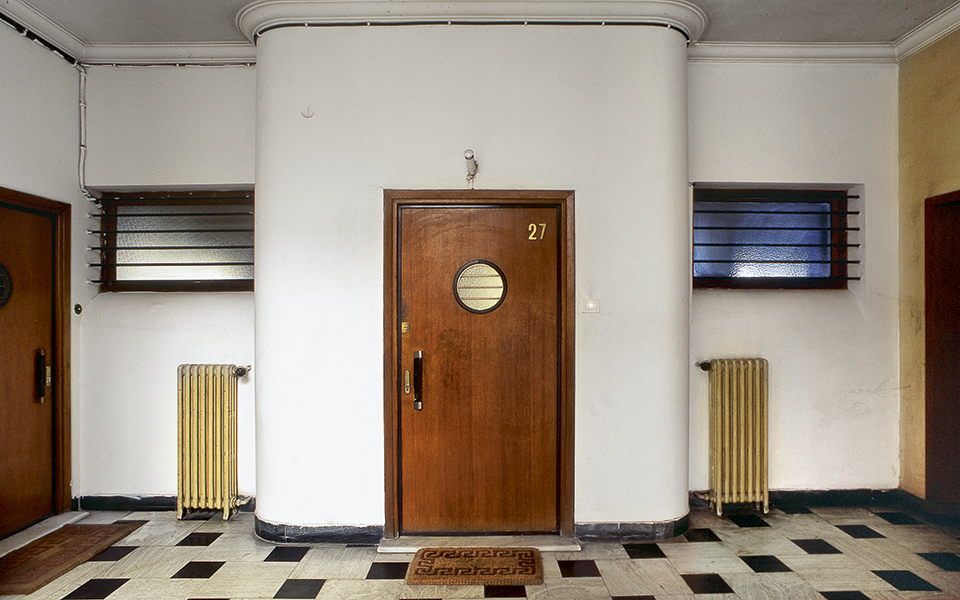Churches, ancient ruins, kiosks and sun-bleached awnings are just some of the typical sights that define Athens. But look around, and you’ll surely notice – walking along its streets or driving by in a cab – that the Greek capital is jam-packed with unsightly multi-story residential buildings festooned with rusty TV aerials poking up from their rooftops and plants growing wild on their balconies. You are looking at examples of the polykatoikia (originally an academic architectural term to describe the Athenian apartment buildings that literally means multi-residence), one of the main architectural typologies encountered in Athens.
We Greeks have always had a love-hate relationship with these cement masses and, for decades, we’ve blamed them for all the stressful factors of city living: the over-population, the ugly cement sprawl, the environmental degradation, the shrinking of public space, the tensions with neighbors over the rules of communal living, the irritating noises coming through paper-thin walls and even our alienation from one another. In the past few years, however, something appears to be shifting in our perception of the polykatoikia. It has become the new “hot” topic in the academic architectural community, with numerous discussions being held in leading cultural forums and with “the apartment building” being presented as a phenomenon at the Venice Biennale of Architecture.
For the end-user as well as the academic, views are changing. Since the start of the financial crisis in particular, many urban residents in Greece (and in other countries around the world) are beginning to embrace and accept the apartment building as part of an effort to better understand their cities and, by extension, themselves. “As time goes by, we inevitably start to love certain things, and the polykatoikia – for better or for worse – is part of our identity,” says architect Panos Dragonas, who recently co-organized a debate on the subject at the Onassis Cultural Center.
POLYKATOIKIA ASYRMATOS, 1967.
ARCHITECT: ELLI VASILIKIOTI (HOUSING PROJECTS DEPARTMENT, MINISTRY OF PUBLIC WORKS)
The Asyrmatos is an urban housing complex standing at the cliff-side edge of Philopappou Hill and Ano Petralona. It is a classical work of Athenian architecture. Marked by slender columns, slabs and parapets ordered in wide bays, stairways and corridor-balconies, it opens its inner life to the city and landscape via two faces – a low one to the east and a higher to the west. The building works as a bridge, gateway and filter between the Acropolis foothills and the dense city beyond. Its rigid block is transfigured through a very simple, exquisite curve swelling out towards the view, reflecting the urban plan, offering difference and variety to its 55 units. A sequence of communal spaces and shops at its base, roof and middle levels, designed to bring together a re-settled community of Asia Minor refugees, opens inside the block. The Asyrmatos grows out of the rock as an ideal re-settlement; it marks an edge between hinterland and city as it looks out towards the sea, bathed in the dramatic evening light. It is a clement monument.
Address: Filopappou Hill & Ano Petralona
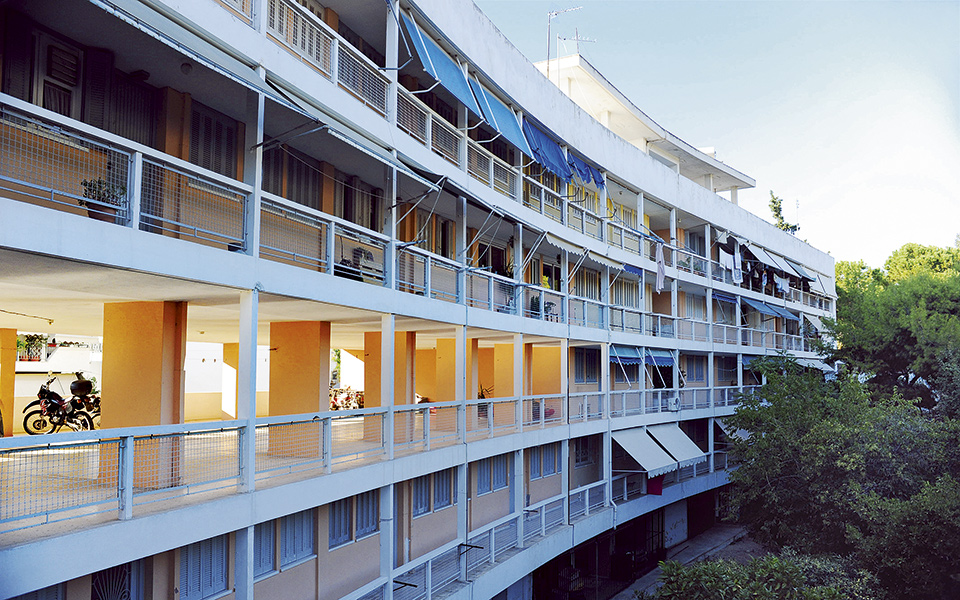
© ASPASIA KOULIRA
In short, if you want to understand Athens – and therefore Greece – it is imperative to get to know some of the history of these mostly family-built residences.
The Greek polykatoikia was born in 1929, thanks to legislation regulating horizontal property ownership, which essentially introduced the notion of antiparochi, an exchange with tax privileges between a property owner and a contractor whereby the former cedes his land or single-dwelling house to the latter, who erects an apartment building on the site. The contractor then hands back to the former owner some of the apartments in the new structure. The city’s earliest apartment buildings were designed and constructed by well-educated and well-traveled architects and contractors who were interested in delivering the best possible result. Typical examples of this period of modernist architecture include the “Blue Polykatoikia” on Exarchia Square, which was designed by Kyriakoulis Panagiotiakοs, and the apartment building on Zaimi Street, built in 1933 by Thoukididis Valentis and Polyvios Michailidis. Style, however, left the proverbial building following the Greek Civil War, when the near-total abandonment of the countryside in the 1950s and ‘60s by tens of thousands of impoverished Greeks put unprecedented pressure on the capital. This prompted unplanned and hurried development, and the phenomenon of the polykatoikia exploded.
THE BLUE POLYKATOIKIA (ANTONOPOULOU), 1933.
ARCHITECT: KYRIAKOS PANAGIOTAKOS
The Blue Polykatoikia is a novel of many chapters, stories within stories that feature famous residents and interface with the cultural and political history of Exarchia over the past 83 years. This complexity is reflected in the volumes, openings, setbacks and exterior spaces contained in its stern-like façade, defining a “vertical neighborhood” as an integral part of Exarchia Square. The Polykatoikia comprises two separate buildings connected at basement and rooftop levels. Its communal spaces are masterfully designed to produce encounters and exchanges among the residents of the 39 apartments. They include a landmark café and a open-area rooftop clubhouse, accommodating a rich communal life vis-à-vis the city. The building, originally colored by the expressionist painter Spyros Papaloukas, is today blue in name only, as it has been repainted.
Αddress: 61 Arachovis & 80 Themistokleous, Exarchia Square
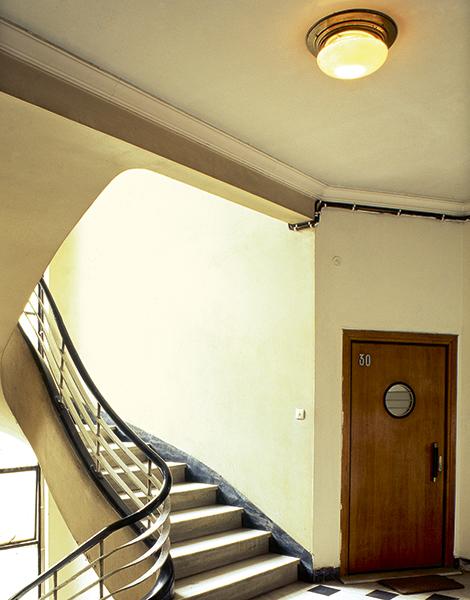
© YIORGIS YEROLYMBOS
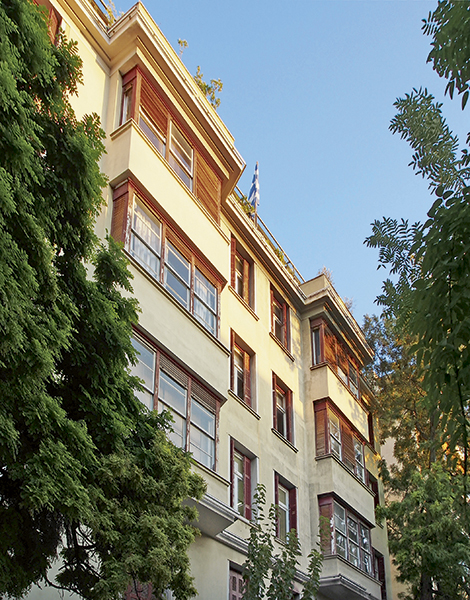
© DIMITRIS TSOUMPLEKAS
POLYKATOIKIA LOGOTHETOPOULOU, 1932
ARCHITECT: KYPRIANOS BIRIS
This building is a historic multi-residence building with a key position in the Athenian political and cultural imagination. Responding to the interwar housing crisis, the architect created housing on a civic scale to accommodate the daily life of the middle class. The building pioneered the use of protruding reinforced concrete volumes (“erker”) as distinctive elements of the Athenian polykatoikia, creating urban thresholds and bringing the private into the public. Its façades, ground floors and terraces were designed as public spaces, integrating arcades, courtyards and light-wells in the service of the 46 units of the block. After the war, the building hosted the National Intelligence Agency, the offices of the Communist Party and the Ministry of Culture. Its historical identity as a memorial, first to torture, oppression and division and then to state bureaucracy, eclipses its design as a public space.
Address: 20-22 Bouboulinas, near Exarchia Square
THE BIG BOOM
“Antiparochi was one of the key concepts of that era. Today, it sounds more like an accounting scheme,” says Dragonas. “As Greece did not have a program for providing cheap housing to the masses, the antiparochi system was a useful tool in dealing with the housing shortage. The state basically allowed its citizens to build their own homes. It lost money through the scheme, but it solved the problem of producing housing. The antiparochi system also boosted the economy. Let’s not forget that construction was one of the basic pillars of the economy before the onset of the crisis.”
The construction bedlam that gripped Athens also became the stuff of comedy, with the 1960 film Ta Dervisopaida (The Dervish Children) by Stelios Tatasopoulos giving us an apt description of the phenomenon. The film starts with a narrator saying: “Athens is changing. The old picturesque Athenian houses are being demolished to make way for huge, modern apartment buildings. Diggers, cranes, machinery and people are working on rebuilding. A new city is being created.” In the next scene, we see two laborers, Tryfonas and Polydoras, working on a construction site. The neighborhood barber asks them if they’ve ever done this sort of work before. “It’s our job,” one of them answers, “but today is the first time that we’re building something.” Shaking his head with contempt, the barber says: “I see. The demolition of Athens has started.”
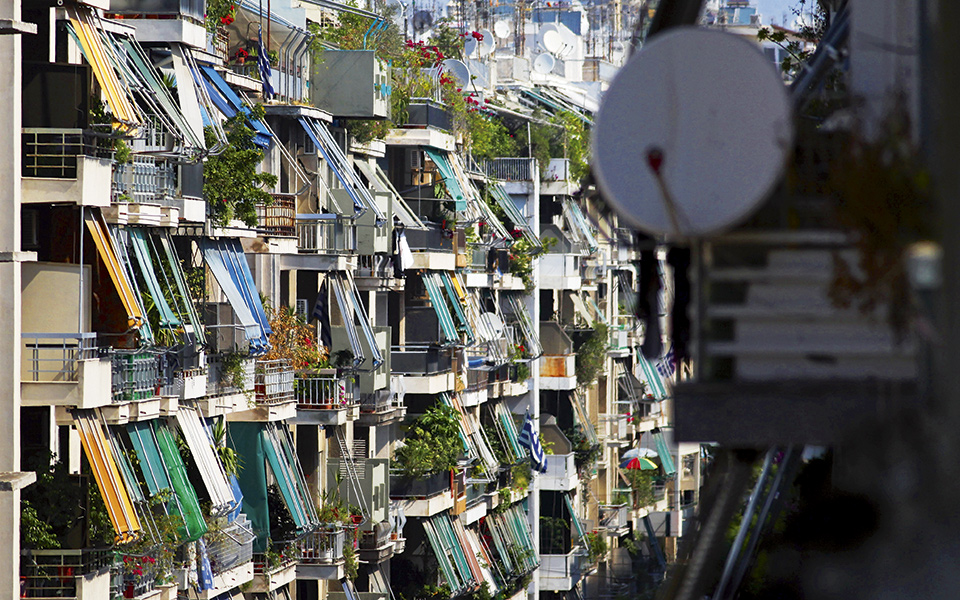
© GETTY IMAGES/IDEAL IMAGE
POLYKATOIKIA ON KIFISSIAS AVENUE, 1958.
ARCHITECT: NIKOS VALSAMAKIS
This apartment building responds to car traffic and the width of a suburban thoroughfare by turning a porous sidewall to the street and opening its long side towards the south. It is made of three articulated parts: a block of flats, a base of free columns containing lower residential units on which that block rests, and a free-floating slab separating the two. The slab creates a canopy for an elegant drop-off and entry zone. The lowest story of the building steps down two levels beyond this zone to a green courtyard. The 18 single- and double-level apartments contain living areas and private spaces separated by sliding panels, a free-flow of uses echoing the flowing horizontal composition of the main volumes. A series of perforated panels shade and shelter the openings. In all, this is an optimistic project: airy and sunny, its classical scale and human proportions signal a 1960s vision of speed and freedom.
Αddress: 272 Kifissias Avenue, Halandri
This scene reveals another interesting fact about the typical polykatoikia: it was somewhat “homemade.” Anyone could – and did – become a builder.
We have, for example, plenty of photographic evidence of housewives plastering walls. “The polykatoikia was a symbol of the prevalence of the metropolitan bricolage culture,” notes Yorgos Tzirtzilakis, an associate professor at Thessaly University’s Department of Architecture. “Apartment blocks were what their residents made them. The bricolage was not the product of one individual but of collectives.”
“Athens was built from the bottom up,” Dragonas says. “There was no central planning. In other countries, cities are designed by urban planning and zoning experts and they are usually separated into residential, commercial and work zones. This never happened here, though the different uses gradually found their place on their own.” Are all the apartment buildings that emerged from the antiparochi system ugly? “It’s not a question of beauty. We are wrong to compare Athens to other European metropolises. The polykatoikia produced something new, regardless of esthetics,” stresses Ioanna Theocharopoulou, assistant professor at Parsons, The New School for Design in New York. “When I started my doctoral thesis on Athens in early 2000, I realized that I had become tired of all the negative stereotypes I kept hearing about it. Athens developed in a piecemeal, unique (for western Europe, at least) manner, and as such is not lacking in interest. Even though it is by no means perfect, it does have many fascinating elements, and the polykatoikia is one of them. I have no intention of exalting it, but it is worthwhile to understand the past, the history and the society that created it. So why don’t we try to understand it on our own terms?”
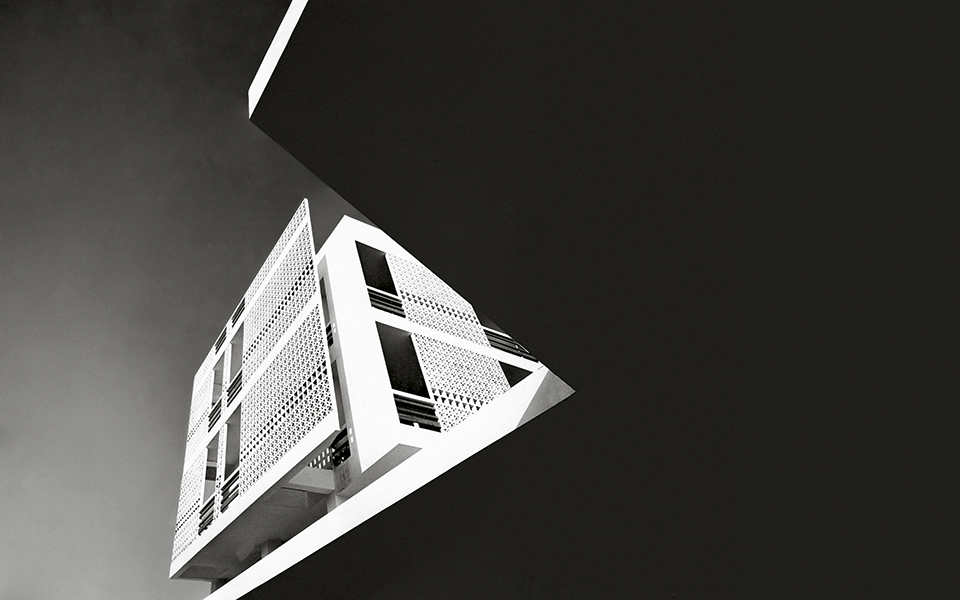
© DIMITRIS KALAPODAS/DOMES INDEX
The typical Athenian apartment building is home not just to residential units, but also to medical practices and offices, and, at street-level, to grocery stores, pharmacies, tailors, art galleries and even movie theaters. For Richard Woditsch, a German architect and a professor of Architectural Theory at the Georg Simon Ohm University of Applied Sciences in Nuremberg, the Athenian apartment building is a charming thing: “It is a modern typology that offers a kind of mixed use: residences and work spaces at the same location. Thanks to this, the ‘interior’ and ‘exterior’ are in constant conversation.”
“The mixture of different uses and the osmosis of public and private space has always been a subject of interest to architects and city planners,” comments Dragonas. “In Athens, this emerged all by itself! This is one of the assets of the polykatoikia; that it brings life to its street.”
Konstantinos Pantazis and Marianna Rentzou of the architectural firm Point Supreme make another observation: “It is important to understand that the polykatoikia is not ugly as an ‘invention’ or ‘building type,’ but in its execution. For example, the apartment buildings in Kolonaki, built by architects in the 1960s, are very beautiful, and anyone would be happy to call them home. The problem is that most apartment buildings were constructed with a view to maximizing profits, without any thought given to the quality of their spaces.”
For Pantazis and Rentzou, the polykatoikia is an important part of their work – which ranges from academic studies to posters and designer souvenirs – as they have specialized in revealing hidden or untapped potential in these trademark structures, transforming them into iconic buildings. “The entire city effectively exists among its apartment buildings,” they argue.
POLYKATOIKIA LANARA, 1938
ARCHITECT: ΙOANNIS ZOLOTAS
The Polykatoikia on Fokionos Negri is part of an interwar development for a “green boulevard,” transforming a rural landscape into an urban one. Fokionos Negri includes significant civic spaces and numerous apartment buildings. The Polykatoikia Lanara is an outstanding project and an integral part of its urban assembly. It presents a masterful façade of balconies, slender openings, protrusions and setbacks, rounding the corner and opening up a great entrance to a crossroad. Its wide communal areas unfold upwards. The building features a number of rounded architectural elements and balances primary and secondary spaces, surfaces, openings and uses at the borders of the public, the communal and the private.
Address: 23 Fokionos Negri & Eptanisou, Kypseli
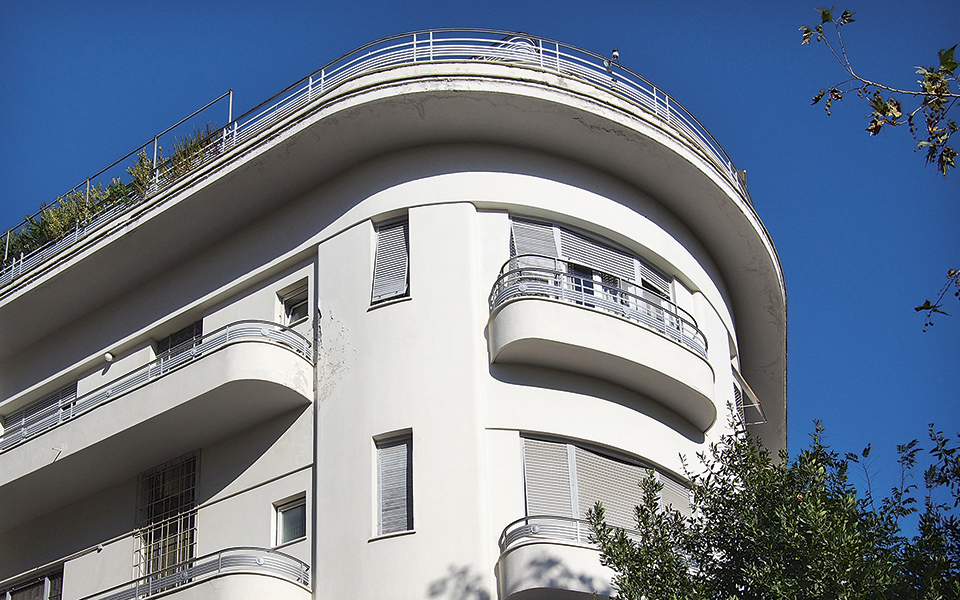
© DIMITRIS TSOUMPLEKAS
CHANGES IN SOCIAL GEOGRAPHY
Between the 1950s and the 1980s, some 35,000 five-story apartment buildings were constructed in Athens, according to Thomas Maloutas, professor at Harokopio University’s Department of Geography. It is worth noting that from 1951-1971, the population within the Municipality of Athens grew by nearly 50% (from 550,000 residents in the 1950s to 800,000 two decades later). The construction boom prompted by this population swell soon drowned the city in concrete. “In order to gain a foothold in society,” Maloutas says, “the junta regime of 1967-74 increased the permissible size of buildings by 20%, thus further boosting construction. If you look at the polykatoikia as nothing more than a concrete mass, then it is reasonable to hate it. But, if you interpret it in a different way, you’ll love it. The success of the antiparochi system was that it leveled social inequalities.”
POLYKATOIKIA AT AMALIAS AVENUE, 1960.
ARCHITECTS: TAKIS ZENETOS, MARGARITIS APOSTOLIDIS
The Polykatoikia on Amalias Avenue is an experimental residential project: a transparent curtain or luminous glass box in the heart of Athens. The building incorporates the 20th-century architectural ideals of the free plan, the blending of inside and outside, and the modular use of prefabricated technologies to create different states of openness. Each floor and apartment is a series of connected spaces, from the wide balconies through the living spaces to the interior private zones. These spaces are separated by sliding panels, doors and windows. The façade features different layers of glass frames, both movable and fixed, filtering air, heat and sunlight through to the interior. The apartments are extensive, providing an open setting for everyday life to be filled by the objects and activities of the residents.
Address: 34 Amalias
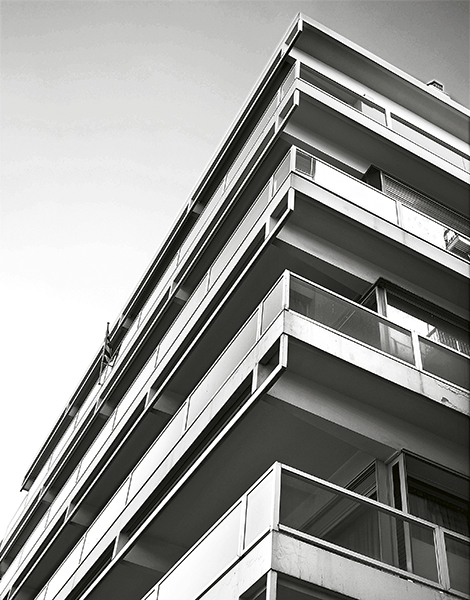
© DIMITRIS TSOUMPLEKAS
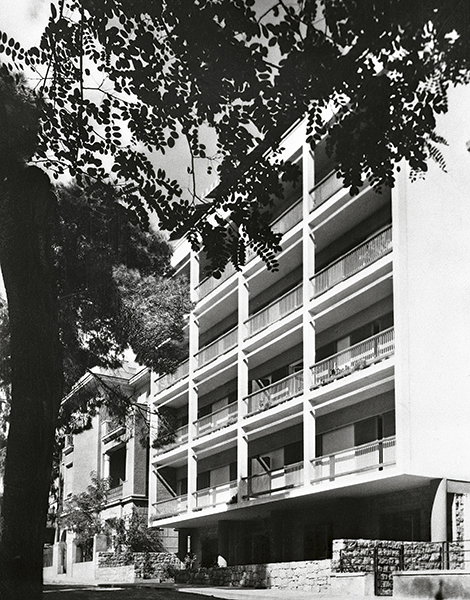
© MORIS ALTSECH/DOMES INDEX
POLYKATOIKIA LOUROU, 1953.
ARCHITECΤ: NIKOS VALSAMAKIS
If the Blue Polykatoikia is a novel, the apartment building on Semitelou Street is a poem. A simple, rational, symmetrically drawn, functionally structured building, it is inventive and consistent in its materials and masterful in its construction. It offers a three-part image of ground floor, living units and skyline to the narrow street. Its layout and façade comprise different but balanced orthogonal shapes. These contain, respectively, smaller compositions of ordered spaces and uses (living, wet, entry, service, sleep), or materials and architectural elements (columns, doorways, shutters, railings, masonry). The Polykatoikia Lourou creates open frames to be filled by the inhabitants. It builds an architectural ideal as a space of everyday life.
Address: 5 Semitelou
What does the professor mean by that? “The richer residents resided on the upper floors; while the less privileged classes lived on the lower floors,” he says, explaining, however, that all the different social classes mingled in the communal areas, such as the foyer and the elevator, while the superintendent – a jack of all trades who was usually granted a small flat in the building in exchange for taking care of all the maintenance work – acted as an intermediary for this disparate group. At the Onassis discussion on the topic, Maloutas, who co-organized the event, was succinct: “The polykatoikia is an excellent example of how the built environment can affect social geography in ways that nobody can predict.”
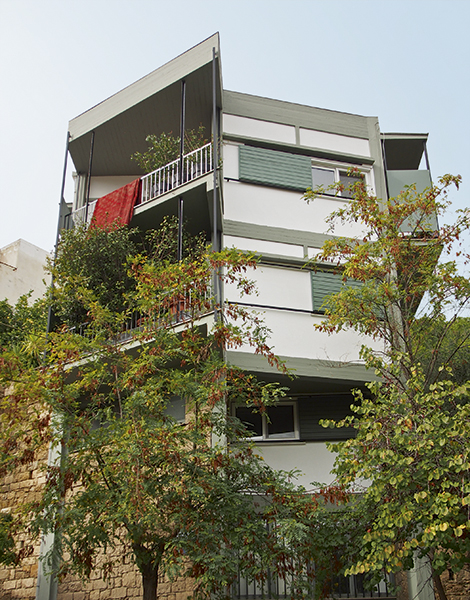
ALEXANDROS XYDIS RESIDENCE, 1961 (© DIMITRIS TSOUMPLEKAS).
“We Greeks have always had a love-hate relationship with these cement masses and, for decades, we’ve blamed them for all the stressful factors of city living.”
AN END OR A NEW BEGINNING?
The antiparochi system and the buildings it created came to an end in 2011 with the onset of the crisis, which led to successive hikes in property taxes and construction material costs, bringing the entire sector to a grinding halt. The need for more housing also dropped. “The polykatoikia is a typology that has completed its historical cycle,” says Tzirtzilakis. “What interests us now is what the next model of mass habitation will be or, more correctly, how the polykatoikia will evolve.”
It is already clear that a demand for transforming existing apartment buildings and adapting them to new uses is on the horizon. “Instead of waiting for an earthquake to solve the problem,” says Woditsch in jest, “architects and city planners need to study how to go about upgrading the interiors and exteriors of these buildings and how to recycle this stock of buildings, both in terms of construction and of society.”
Buildings’ Descriptions by Petros Babasikas

